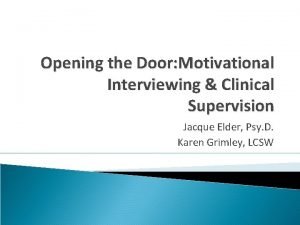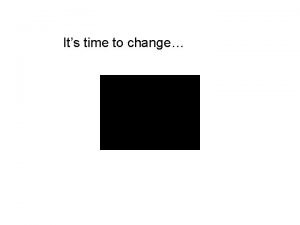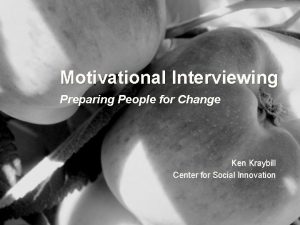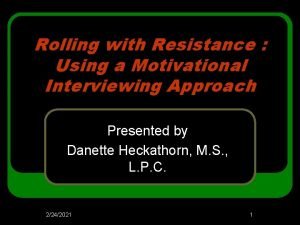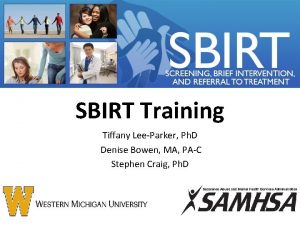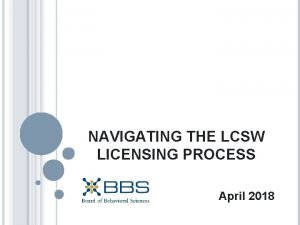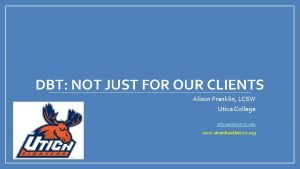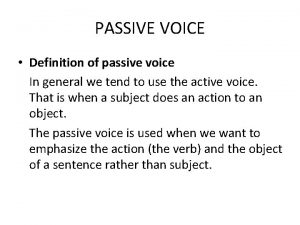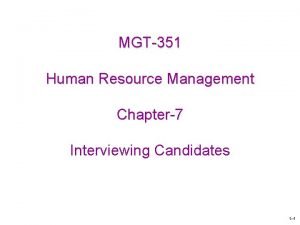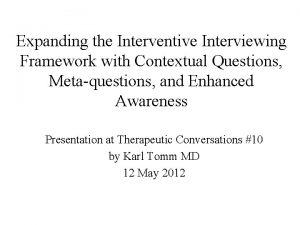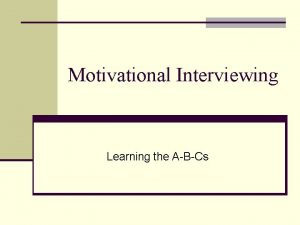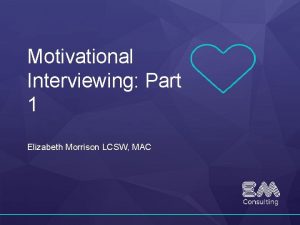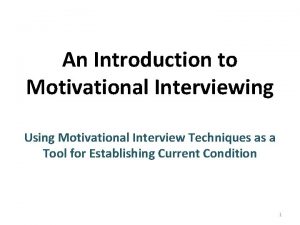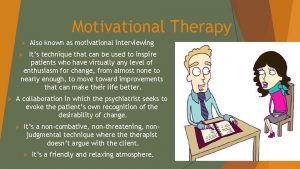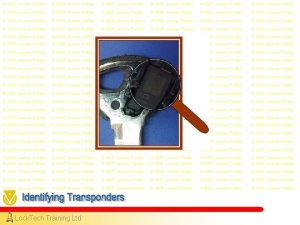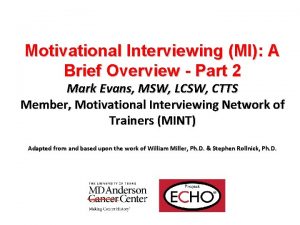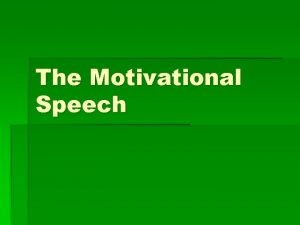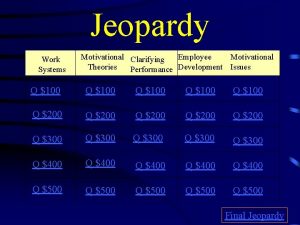MOTIVATIONAL INTERVIEWING AN OVERVIEW Jeremy Wampler LCSW LADC




















































- Slides: 52

MOTIVATIONAL INTERVIEWING: AN OVERVIEW Jeremy Wampler, LCSW, LADC, ICGC-II, BACC Director, DMHAS Problem Gambling Services Jeremy. Wampler@ct. gov

What is Motivational Interviewing?

MOTIVATIONAL INTERVIEWING W. Miller & S. Rollnick • Trapped by Ambivalence • Procrastination, Self Esteem, Self Assertion • Conflict between Indulgence & Restraint • Self-Regulation, Draw on Principles of Social, Cognitive and Motivational Psychology • Client Matching • Nothing Works for Everyone • Counselors must be comfortable with this or they may feel frustrated with a slow paced, ineffectual approach

Motivational Interviewing • Based on “Stages of Change” (Prochaska & Di. Clementi) • Interventions based on enhancing client’s presenting level of motivation

Motivational Interviewing • Counselor/case manager is not the expert • Client has responsibility for change • Strategies are more persuasive than coercive • More supportive than argumentative • Counselor/case manager seeks to create a positive atmosphere conducive to change

Motivation • It is impossible to have an unmotivated client. • Everybody is always motivated towards something. • The question is what?

Why Do People Change? • 1. ? • 2. ? • 3. ?

What prevents people from change? • 1. ? • 2. ? • 3. ?

Key Points about Change 1. Change is difficult and not always comfortable 2. It is easier to stay the same 3. We tend to go back to old ways 4. Change requires creativity 5. Change requires an open mind 6. Change has emotional and cognitive components Broffman, 2011

Key Points about Change 7. Change happens over time 8. The process is as important as the result 9. Often there is a difference between what someone knows they should do and there readiness to do it. 10. Greatest chance to impact change is pairing it to the specific stage of change. Broffman, 2011

Spirit of Motivational Interviewing • Collaboration • Evocation • Autonomy

Collaboration • Helper approaches consumer as a partner • Non-authoritarian • Exploration and support • Opposite: Confrontational or coercive approach

Evocation • Eliciting or drawing out motivation from a client • Drawing on the clients own goals and perceptions presumed to reside in the client • Opposite: Education, enlightenment by an expert

Autonomy • All responsibility for change lies with the client • Respect for autonomy of the client • Client freedom to accept or not accept counsel • Opposite: Client told what to do or what he/she should do

Motivational Cycle and Stages of Change Maintenance Lapse or Relapse Action Planning Precontemplation Contemplation

Matching Intervention to Motivation Precontemplation • Not thinking about change • Not seeing the problem

Matching Intervention to Motivation Precontemplation Goals: • Understand current behaviors/patterns • Understand nature of client’s resistance to consider change • Assess client’s sense of self-efficacy • Express empathy and acceptance • Provide new information • Identify client’s goals for health & well-being • “Just think about it”

Matching Intervention to Motivation Contemplation • Willing to consider a possibility of change • Contemplation is not commitment HOWEVER • Ambivalence can keep client stuck

Matching Intervention to Motivation Contemplation • Anticipate obstacles to change • Work on enhancing coping skills and self-efficacy • Small steps toward change and commitment • Cost-Benefit Analysis of behavior and of change • Evaluate past attempts at changing behavior Goals: • Decrease ambivalence • Strengthen intention to change

Decisional Balance 1) Positive aspects of staying 3) Negative aspects of the same(what are the change (what do I lose if I positive things? ) change? ) 2) What are the negative consequences staying the same(current and future? ) 4) What are the advantages of change(what do I have to gain? )

Matching Intervention to Motivation Preparation • Commitment to stop/change doesn’t make it happen automatically • Assess strength of client’s commitment • Anticipate problems and pitfalls • Provide choices • Develop coping skills and specific action plan Goal: Take action

Matching Intervention to Motivation Action • Ready to implement plan • Use counseling as reinforcement of commitment • External support and motivator • Help increase self-efficacy • Can offer information about range of options for action and change • Monitor change Goal: Support action and change

Matching Intervention to Motivation Maintenance • Relapse prevention and coping • Recycle through stages Goal: Maintain new behaviors, continue positive change

Matching Intervention to Motivation Recurrence/Lapse/Relapse 1. Encourage client to reenter change cycle and reinforce willingness to do so. 2. View recurrence as learning opportunity vs. failure. 3. Reinforce use of coping strategies (don’t use shortcuts). 4. Maintain supportive contact.

Basic Methods • Open questions • Affirmation • Reflective listening • Summary Miller & Rollnick, 2002

Open-ended questions • Open-ended questions are ones that require more than one word answers. • “What are you planning to buy today at the grocery store? ” • “Why is it that every time I talk with you, you seem irritated? ” • “What is your favorite flavor of ice cream and why? ”

Affirmations • Ways to point out the positive aspects of person • Behavior • Intention • Struggles • Thinking • Feelings • Traits, qualities • Affirmations are free • Used not nearly enough

Reflective Listening Client: “I know we made all these goals about my getting out and meeting people, but I’m just not comfortable around other people. ” Worker: “Getting the support you need hasn’t been easy. ” Broffman, 2011

Summary • Special form of reflective listening • Structure: • Indicate you’re about to summarize • Be selective • Note ambivalence and attend to change statements • Be concise! • End with invitation • Use to change directions or ask a key question Broffman, 2011

Eliciting Change Talk • Pushing the ambivalence envelope • Decisional balance between change and the status quo. • Disadvantages of the status quo. • Advantages of change. • Optimism about change. • Intention to change. Miller & Rollnick, 2002

Listen for Change Talk Desire I want/wish/prefer to Ability I can, could, able, possible Reason Why do it? What would be good? Need Important, have to, matter, got to Commitment I will/ am going to – signals behavior change Broffman, 2011

Assessment Outline: Strengths • Support systems • Life Accomplishments • Recovery Experience • Employment/Job skills and training • Finances • Character Assets • Health

Brief Interventions • Focus on motivation is not counseling, skill training etc. • Once motivational decision is made - client may proceed to apply his or her own natural skills to accomplish change

Motivational Traps • Question – Answer Trap • Close ended questions – brief responses • Leading questions that address cm agenda • Active cm – passive client

Motivational Cycle: Case Manager vs. Client Action Maintenance Counselor/CM Lapse or Relapse Planning Client Precontemplation Contemplation

Motivational Traps • Question – Answer Trap: Solution • Use questionnaires to get specific information • Open ended questions followed by reflective listening • Avoid asking too many questions in a row (even open ended ones)

Motivational Traps • Confrontation-Denial Trap • Counselor through best intentions presents information to move client to awareness of their problem and its consequences and prescribes course of action too quickly • Client response: “ My problem isn’t that bad and I don’t really need to do all that”

Motivational Traps • Confrontation-Denial Trap • Natural result of client’s ambivalence. • In conflict over some awareness of need to change gambling and reluctance to give up hopes, fantasies, familiar behavior • If counselor argues for one side of the conflict, client will take opposing side

Motivational Traps It’s not that bad. It’s under control You have a Big Problem

Motivational Traps • Becomes win – lose dynamic • When confronted more forcefully, client can argue themselves out of any change at all in order to “win”

Motivational Traps • Confrontation – Denial Trap: Solution • How can the client “win” therapy • Listen • Empathic reflection • Elicit self-motivating statements

Motivational Traps • Labeling Trap • Labels can carry stigma • Can create power struggle • Client can feel trapped • Lead to confrontation-denial trap Difficult

Motivational Traps • Labeling Trap: Solutions • De-emphasize label • If client raises the issue can respond with reflection and reframing

Motivational Traps • Premature Focus Trap • Focusing on one issue as the problem while the client’s focus is on other issues • The Blaming Trap • Client’s sensitivity to being “blamed”

Difficult Clients: Client Resistance • Client resistance is a helper problem • Extent to which clients “resist” is strongly related to helper’s style • Resistance from the interpersonal interaction of helper and client • Means there is something helper can do about it

Difficult Clients: Styles of Client Resistance • Arguing • Interrupting • Denying • Blaming, Disagreeing, Excusing, Claiming impunity, Minimizing, Reluctance, Unwillingness to change, Pessimism • Ignoring • Misdirection, Inattention, No answer, Not responding

Responses to Avoid Never meet resistance head-on via • arguing, disagreeing, challenging • judging, criticizing, blaming • warning of negative consequences • persuading via logic or evidence • interpreting or analyzing reasons for resistance • confronting with authority • using sarcasm or incredulity *Remember the key is to Roll with the Resistance

Difficult Clients: Strategies • Shifting Focus • Going around barrier, taking a detour • Rolling with Resistance • Agreeing in part with resistance and slightly changing emphasis or focus • Emphasizing Personal Choice and Control • Reframing • Acknowledge validity of client’s observations while offering a new interpretation

Difficult Clients: Strategies • Self-Motivational Statements • Problem Recognition • Expression of Concern • Intention to Change • Optimism about Change

Difficult Clients: Strategies Eliciting Self-Motivational Statements • Evocative Questions • Cost-Benefit Balance • Elaboration • Describing Extremes • Looking Back • Looking Forward • Exploring Goals

References Hodgins, D. C. , Currie, S. R. & el-Guebaly, N. (2001). Motivational enhancement and self-help treatments for problem gambling. Journal of Consulting and Clinical Psychology, 69, 50 -57. Miller, W. R. & Rollnick, S (1991). Motivational Interviewing: Preparing people to change addictive behaviors. New York: Guilford Press. Prochaska, J. O. , Norcross, J & Di. Clementi, C. 1994. Changing for Good. 1994. New York: Avon Books. Broffman, T. , (2011). Motivational Interviewing Intensive. DMHAS Education and Training Division. Middletown.

May your motivation match your dreams. Thank you
 Motivational interviewing traps
Motivational interviewing traps Ladc programs in ma
Ladc programs in ma Motivational interviewing basics
Motivational interviewing basics Krishna guadalupe
Krishna guadalupe Motivational interviewing
Motivational interviewing Motivational interviewing case management
Motivational interviewing case management Motivational interviewing
Motivational interviewing Motivational interviewing
Motivational interviewing Mi readiness ruler
Mi readiness ruler Dares motivational interviewing
Dares motivational interviewing Motivational interviewing dears
Motivational interviewing dears Agreement with a twist motivational interviewing
Agreement with a twist motivational interviewing Motivational interviewing
Motivational interviewing Dears motivational interviewing
Dears motivational interviewing Darn cat motivational interviewing
Darn cat motivational interviewing Stages of change in social work
Stages of change in social work Ears in motivational interviewing
Ears in motivational interviewing Reds motivational interviewing
Reds motivational interviewing Motivational interviewing
Motivational interviewing Motivational interviewing preparing people for change
Motivational interviewing preparing people for change Motivational interviewing schizophrenia
Motivational interviewing schizophrenia Darn cat motivational interviewing
Darn cat motivational interviewing Darn cat motivational interviewing
Darn cat motivational interviewing Motivational interviewing stages of change
Motivational interviewing stages of change Rolling with the resistance
Rolling with the resistance Darn cat motivational interviewing
Darn cat motivational interviewing Double sided reflection example
Double sided reflection example Darn cats motivational interviewing
Darn cats motivational interviewing Me llamo yo
Me llamo yo Ron unger lcsw
Ron unger lcsw Bipolar spiritual gift
Bipolar spiritual gift Dr julie larson
Dr julie larson Bbs asw
Bbs asw Julie larson lcsw
Julie larson lcsw Alison franklin lcsw
Alison franklin lcsw Kv charts in software testing
Kv charts in software testing Node reduction algorithm in software testing
Node reduction algorithm in software testing S+tobe+ving
S+tobe+ving Nursing interview techniques
Nursing interview techniques Chapter 7 interviewing candidates
Chapter 7 interviewing candidates Performance monitoring and coaching reflection
Performance monitoring and coaching reflection Chapter 7 interviewing candidates
Chapter 7 interviewing candidates Interview techniques definition
Interview techniques definition Kvale seven stages of interviewing
Kvale seven stages of interviewing Intensive interviewing
Intensive interviewing Relay assembly experiment
Relay assembly experiment Interviewing techniques journalism
Interviewing techniques journalism Advanced interviewing techniques
Advanced interviewing techniques Interviewing techniques social work
Interviewing techniques social work Karl tomm interventive interviewing
Karl tomm interventive interviewing Hornstrup
Hornstrup Performance based interviewing
Performance based interviewing The craft of interviewing in realist evaluation
The craft of interviewing in realist evaluation







